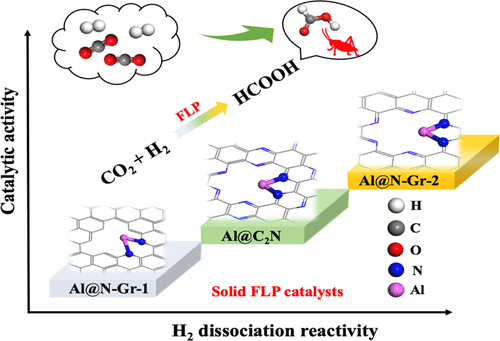当前位置:
X-MOL 学术
›
ACS Appl. Mater. Interfaces
›
论文详情
Our official English website, www.x-mol.net, welcomes your feedback! (Note: you will need to create a separate account there.)
Rational Design of Main Group Metal-Embedded Nitrogen-Doped Carbon Materials as Frustrated Lewis Pair Catalysts for CO2 Hydrogenation to Formic Acid
ACS Applied Materials & Interfaces ( IF 9.5 ) Pub Date : 2021-12-22 , DOI: 10.1021/acsami.1c20230 Yue Zhang 1 , Yirong Mo 2 , Zexing Cao 1
ACS Applied Materials & Interfaces ( IF 9.5 ) Pub Date : 2021-12-22 , DOI: 10.1021/acsami.1c20230 Yue Zhang 1 , Yirong Mo 2 , Zexing Cao 1
Affiliation

|
Developing efficient and inexpensive main group catalysts for CO2 conversion and utilization has attracted increasing attention, as the conversion process would be both economical and environmentally benign. Here, based on the main group element Al, we designed several heterogeneous frustrated Lewis acid/base pair (FLP) catalysts and performed extensive first-principles calculations for the hydrogenation of CO2. These catalysts, including Al@N-Gr-1, Al@N-Gr-2, and Al@C2N, are composed of a single Al atom and two-dimensional (2D) N-doped carbon-based materials to form frustrated Al/C or Al/N Lewis acid/base pairs, which are all predicted to have high reactivity to absorb and activate hydrogen (H2). Compared with Al@N-Gr-1, both Al@N-Gr-2 and Al@C2N, especially Al@N-Gr-2, containing Al/N Lewis pairs exhibit better catalytic activity for CO2 hydrogenation with lower activation energies. CO2 hydrogenation on the three catalysts prefers to go through a three-step mechanism, i.e., the heterolytic dissociation of H2, followed by the transfer of the hydride near Al to CO2, and finally the activation of a second H2 molecule. Other IIIA group element (B and Ga)-embedded N-Gr-2 materials (B@N-Gr-2 and Ga@N-Gr-2) were also explored and compared. Both Al@N-Gr-2 and Ga@N-Gr-2 show higher catalytic activity for CO2 hydrogenation to HCOOH than B@N-Gr-2. However, the CO2 hydrogenation path on Ga@N-Gr-2 tends to follow a two-step mechanism, including H2 dissociation and subsequent hydrogen transfer. The present study provides a potential solution for CO2 hydrogenation by designing novel and effective FLP catalysts based on main group elements.
中文翻译:

主族金属包埋氮掺杂碳材料作为二氧化碳加氢制甲酸的受阻路易斯对催化剂的合理设计
开发用于CO 2转化和利用的高效且廉价的主族催化剂已引起越来越多的关注,因为该转化过程既经济又环保。在这里,我们基于主族元素Al,设计了几种非均相受挫路易斯酸/碱对(FLP)催化剂,并对CO 2的加氢进行了广泛的第一性原理计算。这些催化剂,包括 Al@N-Gr-1、Al@N-Gr-2 和 Al@C 2 N,由单个 Al 原子和二维(2D)N 掺杂碳基材料组成受挫的 Al/C 或 Al/N Lewis 酸/碱对,都被预测具有高反应性以吸收和活化氢 (H 2)。与Al@N-Gr-1相比,含有Al/N路易斯对的Al@N-Gr-2和Al@C 2 N,尤其是Al@N-Gr-2均表现出更好的CO 2加氢催化活性,且具有较低的催化活性。活化能。三种催化剂上的CO 2加氢更倾向于经历三步机理,即H 2的异解离解,随后Al附近的氢化物转移到CO 2,最后激活第二个H 2分子。还探索和比较了其他 IIIA 族元素(B 和 Ga)嵌入的 N-Gr-2 材料(B@N-Gr-2 和 Ga@N-Gr-2)。Al@N-Gr-2 和 Ga@N-Gr-2 对 CO 2均表现出更高的催化活性氢化为 HCOOH 而不是 B@N-Gr-2。然而,Ga@N-Gr-2 上的 CO 2加氢路径倾向于遵循两步机制,包括 H 2解离和随后的氢转移。本研究通过设计基于主族元素的新型有效的 FLP 催化剂,为 CO 2加氢提供了潜在的解决方案。
更新日期:2022-01-12
中文翻译:

主族金属包埋氮掺杂碳材料作为二氧化碳加氢制甲酸的受阻路易斯对催化剂的合理设计
开发用于CO 2转化和利用的高效且廉价的主族催化剂已引起越来越多的关注,因为该转化过程既经济又环保。在这里,我们基于主族元素Al,设计了几种非均相受挫路易斯酸/碱对(FLP)催化剂,并对CO 2的加氢进行了广泛的第一性原理计算。这些催化剂,包括 Al@N-Gr-1、Al@N-Gr-2 和 Al@C 2 N,由单个 Al 原子和二维(2D)N 掺杂碳基材料组成受挫的 Al/C 或 Al/N Lewis 酸/碱对,都被预测具有高反应性以吸收和活化氢 (H 2)。与Al@N-Gr-1相比,含有Al/N路易斯对的Al@N-Gr-2和Al@C 2 N,尤其是Al@N-Gr-2均表现出更好的CO 2加氢催化活性,且具有较低的催化活性。活化能。三种催化剂上的CO 2加氢更倾向于经历三步机理,即H 2的异解离解,随后Al附近的氢化物转移到CO 2,最后激活第二个H 2分子。还探索和比较了其他 IIIA 族元素(B 和 Ga)嵌入的 N-Gr-2 材料(B@N-Gr-2 和 Ga@N-Gr-2)。Al@N-Gr-2 和 Ga@N-Gr-2 对 CO 2均表现出更高的催化活性氢化为 HCOOH 而不是 B@N-Gr-2。然而,Ga@N-Gr-2 上的 CO 2加氢路径倾向于遵循两步机制,包括 H 2解离和随后的氢转移。本研究通过设计基于主族元素的新型有效的 FLP 催化剂,为 CO 2加氢提供了潜在的解决方案。



























 京公网安备 11010802027423号
京公网安备 11010802027423号